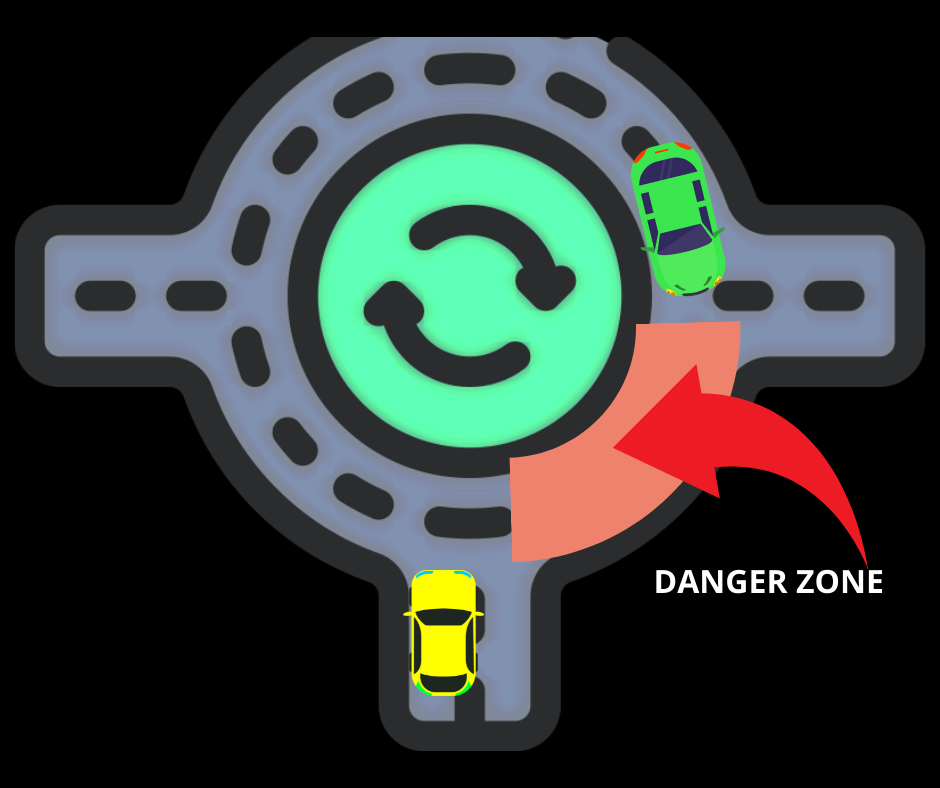Not Making Effective Observations at Roundabouts is the Top Reason for Failing a Driving Test
Roundabouts come under the same category as road junctions on your driving test results sheet. Read the previous article and watch the video on “Not making effective observations at junctions”. It’s the top category for failing a driving test.
What is classed as
effective observations
at roundabouts?

Look at the diagram above and you will notice a yellow car entering the roundabout and a green car already on the roundabout. The danger zone shown with the arrow is the space you should be aware of.
When this danger zone has a vehicle inside it you should rarely go onto the roundabout, no matter how many lanes there are. Assuming you are the yellow car and a vehicle is entering this zone from the right-hand lane and signalling right still has priority. The green car is allowed to switch lanes to the left in order to exit the roundabout. The switching of lanes could occur in front of the yellow car.
Don’t stare at the traffic
Most of my pupils in the early stages of their driving lessons stare at the traffic, instead of looking for a safe opportunity to proceed. You might think that it’s the same thing but it’s not. When you stare only at the traffic or more precise the vehicles on the right of your car your mind is blocking out the bigger picture of other movements occurring. Once you take an overall observation by approaching at a controlled speed you make better decisions about when to move onto the roundabout.
Recipie for disaster
Approaching a roundabout too fast and assessing traffic too hasty is a recipe for disaster.
- You misjudge the speed of other vehicles
- A vehicle might enter the danger zone quicker than you anticipated
- Assuming you are driving the yellow car and another driver decides to speed up from the road on your right, trying to beat the green car. This causes you to brake sharply and the car that is behind crashes into your yellow car.
- Approaching too fast and then deciding to stop because you want more time to assess the situation will result in the same outcome as item 3. Because the driver behind you gets the wrong impression and expects you to carry on through the roundabout.
- Assume you have failed your driving test on any of the previous cases. You now decide to be extra cautious and approach the roundabout very slowly, stop and look then wait for other traffic to clear. Then cautiously drive onto the roundabout.
You fail your test again. Why? You might ask. I was slower and cautious, what’s the problem? The problem is you haven’t followed roundabout rules. Roundabouts were designed to keep traffic flowing, but in a safe way. By stopping and assessing you are not flowing. - Get ready for your driving test
Mini-roundabouts
Mini-roundabouts call for a different driving strategy, despite the Highway code stating that they should be treated as normal roundabouts. As mentioned earlier roundabouts are designed to keep traffic flowing, but at mini-roundabouts, you can’t always flow. The mini-roundabout was designed to slow traffic at road junctions where two or more roads cross.
When approaching a mini roundabout the view to your right is not always good enough to keep the car flowing. There could be a building or garden completely blocking the view to the right. In this case, you would need to either be very slow or stop before entering the roundabout. If it’s a large hedge blocking your view to the right a car approaching from the right would see you before you notice it’s there. So creeping onto the roundabout would be essential in this case.
